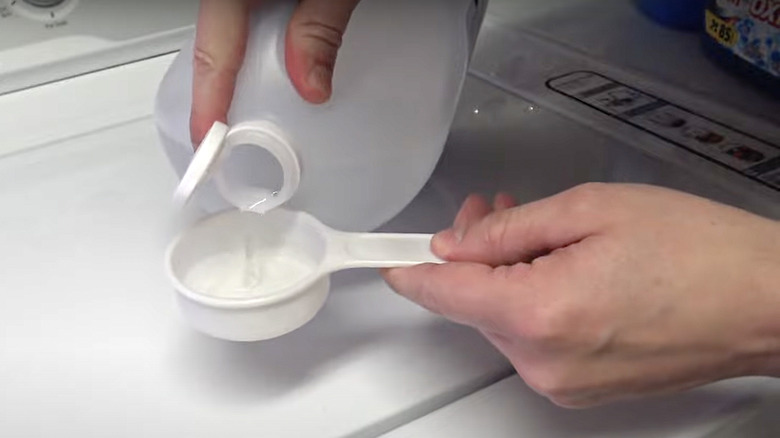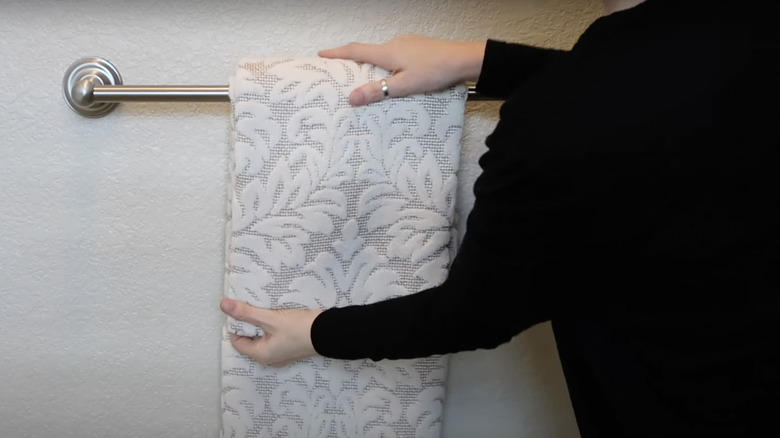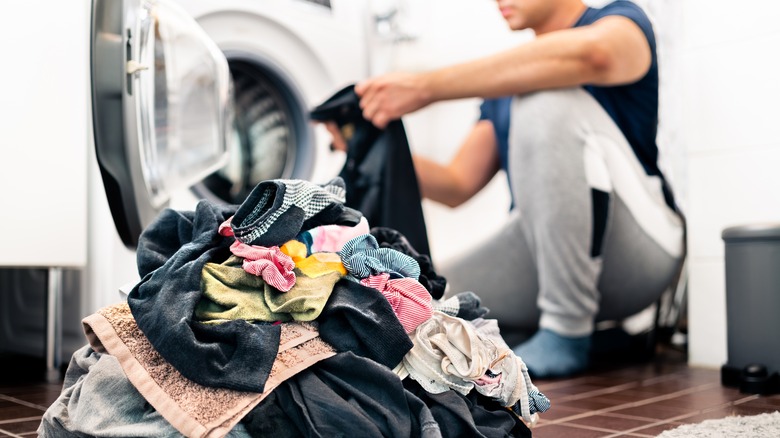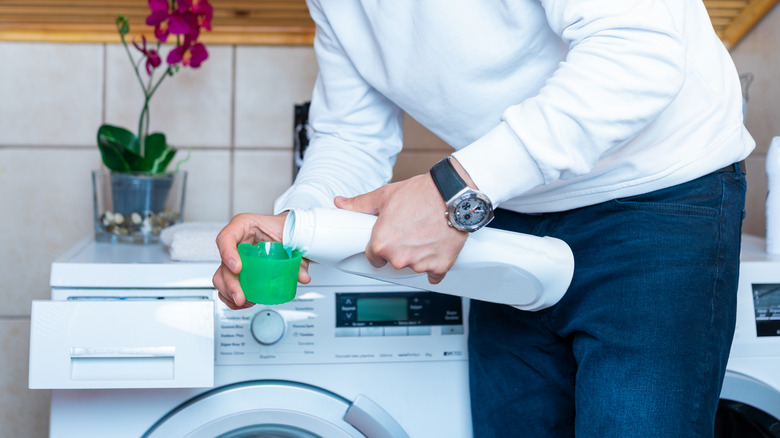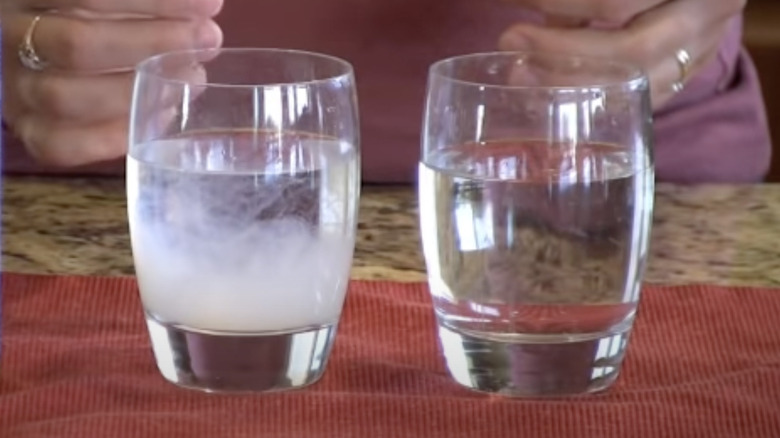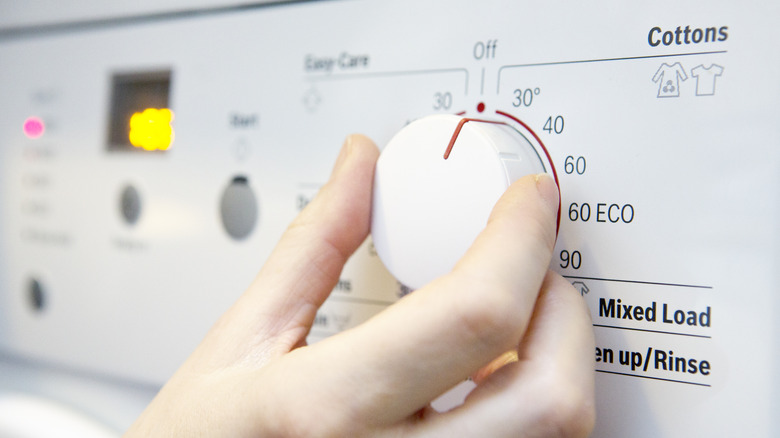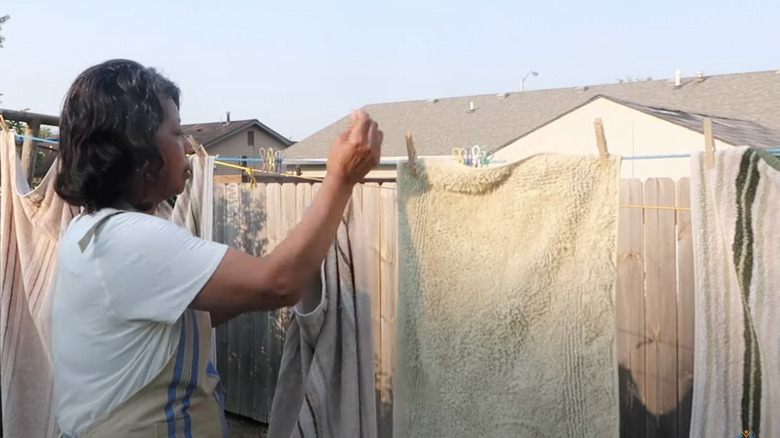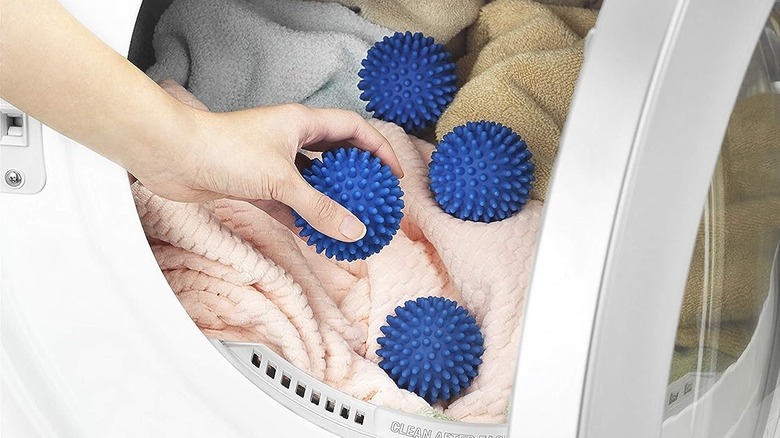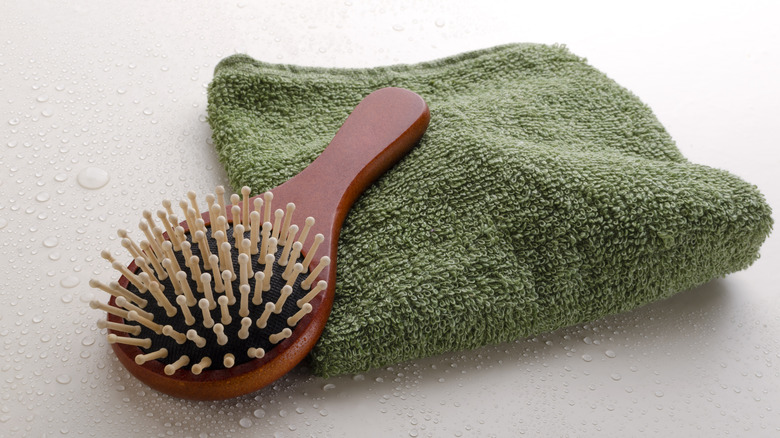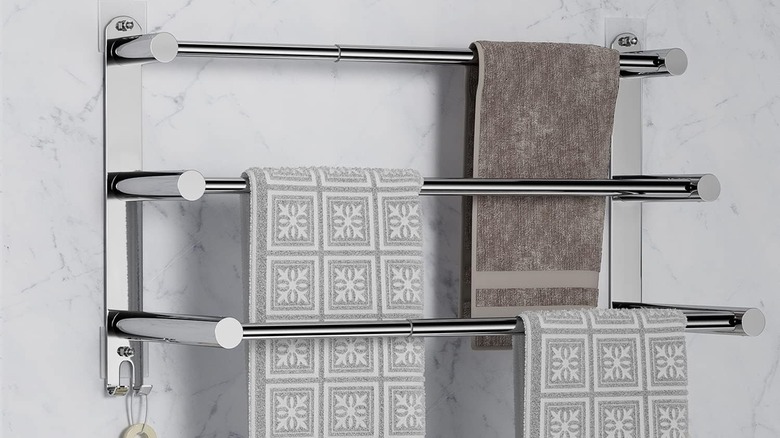Tips To Resoften Even Your Most Musty Towels
The towels you find in stores always seem more luxurious than the ones back home. Unwashed and unused, they're often plush to the touch and have a crisp fresh-out-of-the-factory scent. While your towels at home may seem drab and incomparable, the truth is that you can restore your current collection to its former glory with a little work. You don't have to buy the highest quality Turkish and Egyptian cotton towels to have a cozy post-shower or pool experience. You just need to know what you've been doing wrong and how you can change your ways to take better care of the musty towels currently in your possession.
After daily use and weekly washer and dryer cycles, it's inevitable that towels begin to lose their soft feel. The fabric fibers get pressed down, diminishing their flouncy shape. Over time, the fibers may also take on a stale smell that seems impossible to erase. Despite their current state, don't give up on your towels just yet. By changing your washing, drying, and storage habits, you can make them just as fluffy as they were the first day you brought them home. Below are some tips for revitalizing your towels, which you'll find useful for improving their smell, absorbency, and appearance.
Use household staples like vinegar and baking soda
Vinegar and baking soda are the dynamic duo cure-all for household cleaning. This simple but effective formula can benefit various home amenities, including your musty years-old towels. Distilled or cleaning vinegars contain mostly water and five or six-percent acetic acid, respectively (via How Stuff Works). They're all-natural and non-toxic products that remove soapy, greasy, and oily buildup, especially when combined with baking soda, which is also known as sodium bicarbonate. The combination of these two natural cleaning remedies creates a chemical reaction that helps dissolve stains and dislodge soap scum, making it the ideal solution for freshening towels.
Use one cup of vinegar instead of traditional laundry detergent between every two to four washes. Operate your machine using the same wash and dryer cycle you typically use, or follow the wash instructions found further down this article. Your towels should be cleaned and sanitized as an end result. If you still feel some soapy residue or buildup, add a half-cup of baking soda and run the wash again. Just make sure you don't combine bleach with these ingredients, for the combination of distilled white vinegar and bleach creates the dangerous chemical reaction of chlorine gas.
Let your towels dry before throwing them in the wash pile
If you're looking for low-effort ways to keep your towels fresh, ensure they're fully dry before you wash them. Nearly everyone has made the mistake of throwing dirty towels in a heap, whether in a designated hamper or an improvised clothing pile at the back of a closet. In both of these cases, the towel fabric is slumped together and isn't receiving proper ventilation. This causes bacterial growth, which in turn leads to grimy buildup and a foul smell.
Instead of dropping your dirty towel in a pile for your next laundry day, hang it up and let it dry first. Drape it across a wide bathroom rod to ensure the towel is fully spread out and all the fabric is properly ventilated. Don't use wall hooks, even if they're designed for towels. These contraptions hold the towel in a folded fashion that still doesn't allow ventilation. The way it hangs from a hook keeps certain layers from airing out, therefore still leading to that mildewy texture and smell.
Lighten your laundry loads by washing towels separately
Taking a more calculated approach to washing laundry can also solve your musty towel epidemic. According to a study published in the National Library of Medicine, kitchen, hand, and face towels had some of the highest concentrations of bacteria, even after being washed and dried. This is due to the thickness of their fabric, which traps bacteria more easily and makes it harder to wash. These facts alone should convince most people to launder their towels separately from bed sheets, clothes, and other fabrics.
Placing your towels in a separate load gives you more control over the wash settings without you needing to worry about other garments that could be mixed in. You can adjust the time, heat, detergent, fabric softener, vinegar, and baking soda amounts based on your towels' wash and dry instructions or your personal preferences. This helps to avoid over- or under-drying them, both of which deteriorate the fluffy fabric and take away from the cozy, fresh feel of a good towel after a shower or wash-up.
Be picky and stingy when it comes to detergent
When you aren't using vinegar or baking soda, you should be conscientious about the amount and type of detergent you're using for your towels. It's best to remember that "less is more" when it comes to soap or cleaning solutions. The truth is that too much detergent makes it harder for your machine to wash your laundry and often leaves a soapy residue on fabrics.
The soap scum buildup makes your towels grimy, dry, and moldy, which is the opposite of detergent's intended effect. According to the New York Times, one tablespoon of detergent is enough for about eight pounds, or a normal-sized load, of laundry. It's theorized that detergent companies advise using more soap per load because consumers will have to restock more frequently, therefore buying more of their products.
In addition to using the right amount of soap, you should also be aware of what's in your cleaning products. It's recommended you avoid using products that use "fragrances" for scent. Fragrances contain hundreds of chemicals to create their unique smells. Instead, opt for an unscented detergent and add a few drops of essential oils to make your laundry smell good without unneeded additives. You should also avoid detergents with sulfates, phosphates, and chlorine bleach, which gradually break down fibers and reduce towel absorbency over time.
To find the best detergent for you, look for unscented brands designed for sensitive skin, as these tend to have fewer questionable ingredients. However, the only way to ensure you're truly choosing a safe detergent is to check out the ingredient label on the back and make sure it's made without artificial preservatives, dyes, thickeners, brighteners, and synthetic fragrances. Keep in mind that liquid detergents reportedly perform better than pods and powder options, according to another study by the New York Times.
Make sure your plumbing has soft water
Even if you follow the best practices for washing your towels, they can still turn out crusty and uncomfortable due to issues beyond your washing machine and technique. The water cycling through your home plumbing has a large impact on your laundry and may be the culprit behind your musty towel problem. You may have hard water, which isn't just a rural issue, as many mistakenly believe. Hard water can be a problem in country, suburban, and urban areas alike, and is when household water has high concentrations of minerals like calcium, iron, and magnesium. These minerals aren't necessarily dangerous, but high amounts make washed garments appear dingy and feel rough to the touch.
The solution to this problem doesn't lie in any changes to your laundry habits; rather, you'll need to make adjustments to your home plumbing. Most people invest in a water softener or whole-house filtration system to reduce mineral presence in their pipelines. These systems are an additional step in plumbing systems that essentially purify water before it's used by plumbing fixtures, meaning hard water will no longer bombard towels in the washing machine. This usually requires calling a plumber or specialist to hook up a compatible system to your home. After the installation, you'll notice that all your garments, not just towels, will come out fresher and cleaner.
Choose the right wash cycle
Another way to revitalize your oldest towels is to make sure you're washing them on the correct settings. Most modern-day washers have a plethora of settings and customization options designed to ease everyday washing. However, the multitude of options makes it overwhelming to determine which setting you should use. When it comes to towels, ensure you're washing them on a setting warm enough to eliminate bacteria but not too hot that it damages the soft, fluffy fibers that make up the fabric.
Put towels in your machine and dial it to the warm or regular setting. Most laundry machines consider warm to be around 90 degrees Fahrenheit, which is the most common setting used to prevent shrinkage, fading, and other laundry damage while still cleaning items thoroughly. In short, this wash setting cleans, dissolves detergents, and kills accumulated bacteria. A good wash sets you up for a good drying routine to help your towels stay fluffy and cozy throughout their lifespan.
Only tumble-dry occasionally
A quick tumble in the dryer is one of the best-known tricks for fluffing up fabrics on the fly. Despite how effective this method may be, you should use the dryer sparingly when it comes to your towels. Constantly blasting high heat for extended periods, even if only for a few minutes, gradually wears out fibers and ages your towels quicker. You can dry your towels like this on occasion, but just know that taking other methods will greatly extend their quality.
Instead of tumble drying after every wash, consider hanging up your towels the old-fashioned way by draping them over rods or clotheslines to air dry. After they are fully dry, shake them out to fluff out the fabric. You don't have to completely forgo your use of your dryer– you can also try spinning the towels on a cool-blast or non-heated setting to make the fibers stand up like new.
Use tennis balls or dryer balls for the drying cycle
On the rare occasion that you do throw your towels in the dryer, you can use the acclaimed "tennis ball" hack to make your towels extra fluffy. Tossing a couple of tennis balls in your dryer keeps the towels separated as they spin, allowing them to dry more efficiently. The separation enables more air circulation, which keeps fabrics from twisting and weighing each other down throughout the drying cycle. Your towels should emerge from the dryer evenly dried, with less static and a plusher feel.
In The Wash recommends using two balls for a small load, four for a medium load, and six for a large load, though you can alter how many balls you use based on your own machine and laundry needs. Although tennis balls are the original concept, you can also purchase specially designed wool or plastic balls that serve the same purpose. Many major retailers sell dryer balls, or you can make them yourself, making them an easy asset to obtain and add to your laundry endeavors.
Brush your towels with a hairbrush
Fans of the early 2000s Disney channel might remember that episode of "Wizards of Waverly Place," where a character fondly brushes her carpeted walls with a hairbrush to make them appear more feathery and appealing. Although this moment is played for laughs, it's actually a useful tip for sprucing up fluffy fabrics around your home. Hairbrushes are useful for styling hair the way we want it to look, so it's only natural that this method also works on towels. If your fluffy towels are looking a little flat, you can use a brush to tease up the fabric fibers and give them a fuller look.
Before you begin, ensure the towel is fully dry. Wet fabric is more prone to fraying and may change shape as it dries, making your efforts fruitless. Use a wide-toothed brush to avoid breaking apart thicker fabric fibers, and use gentle strokes to make the towel look and feel thicker and softer. This is a time-consuming task compared to other methods of refreshing towels, but is an effective way to upgrade their appearance for your own satisfaction or to impress houseguests.
Don't store towels on top of one another
The way you store your towels also impacts their appearance and condition. The normal approach is to roll or fold towels before storing them away in closets and cabinets, but you should avoid piling them on top of one another. Towels tend to be heavier than other garments and linens, and the taller the pile goes, the more weight that presses down on the bottom layers. The towels at the very bottom are squashed until they are unsightly and drab, and the lack of air circulation also leaves them smelling musty.
Lucy Ackroyd, a head designer at Christy, recommended to Homes and Gardens to, "...try neatly folding them side by side instead," so your collection of towels doesn't weight down on itself. You could also invest in a tower rack or ladder shelf, which allows you to stagger your towel placement on a display. Just make sure you don't lay multiple towels over one another, as too much weight can break the rungs in the display or flatten your towels, bringing you back to the same issues you get from stuffing your collection in a compact pile.
Occasionally take them to the dry cleaner
At the end of the day, it doesn't hurt to get professional help with fluffing up old towels. No one knows laundry better than those who specialize in cleaning and refurbishing these products for a living. Many people don't realize that dry cleaning companies happily dry-clean more than professional attire, formalwear, and clothing designated dry-clean only. They'll take your towels, washcloths, and similar items and wash them thoroughly and gently.
It's a dry cleaner's job to return garments and fabrics in better condition than when they were received. Depending on what is most practical for your financial situation and schedule, you should plan occasional visits to have your towels fluffed and refurbished. Cleaning your towels in this manner is bound to get you better results than you could have gotten at home. The dry cleaner should thoroughly scrub them clean of detergent buildup, bacteria, stains, and grime, making them more absorbent and fresh-smelling to your satisfaction. The only thing to keep in mind is that the more towels you have and the more luxurious they are, the more costly these visits will be. Thicker towels take more care and are heavier, and most dry cleaners charge by the weight of your drop-off.

